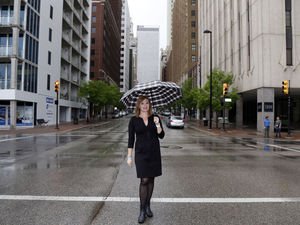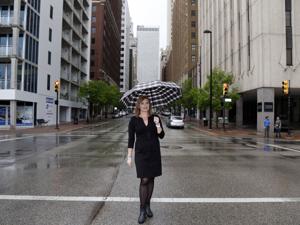

Amanda DeCort is blunt about her belief in the ability of architecture to raise a community’s spirit and in her belief that the attitude of Tulsans toward downtown treasures has changed.
“I think that interest took a nap for a while, so it’s been fantastic to see all of the excitement about downtown, and the appreciation for the architecture, and now the residential living in that area as well,” said the executive director of Tulsa Foundation for Architecture.
“We’ve stemmed the tide from tearing down buildings and making new parking lots (in the past). We missed the boat on that for several decades, but expectations have changed.”
It’s a sense of community that DeCort has helped to create through her historic preservation efforts while working at City Hall and now through TFA events like the wildly popular downtown walking tours.
Now, she said she hopes to further grow that sense of place and of pride in a city’s design aesthetic, with an innovative film festival.
The Architecture & Design Film Festival begins Thursday at Circle Cinema, presenting 20 films focused on the best architecture and design from around the world over four days.
Staged in New York and Los Angeles in past years, the festival is adding a visit to Tulsa for 2017 among stops in Seoul, South Korea, and New Orleans.
The goal is for the Tulsa edition of the Architecture & Design Film Festival to become an annual event, said ADFF founder and festival director Kyle Bergman.
He said the goal is to exhibit films that not only highlight great designs but also engage the public “by bringing them together to enjoy a festival and to talk about their community.”
Beginning a dialogue on architecture and design between professionals and the public is exactly what Mayor G.T. Bynum spoke of in February when the festival was announced, referring to downtown’s Art Deco-inspired buildings and the modern BOK Center as “the splendor of what we get to live in on a day-to-day basis.”
As a festival example of this, Thursday’s opening-night event features a screening of “Strange and Familiar: Architecture on Fogo Island,” a documentary about a Newfoundland community’s decision to revitalize by constructing a series of striking new buildings.
This screening is a benefit for Tulsa Foundation for Architecture, where DeCort and others have worked to deepen people’s knowledge of the city’s architecture and design, from yesterday and today.
These events have included the hot-ticket downtown building and tunnel tours (950 guests on a Saturday earlier this year) and “Dwell in the IDL” tours, with more than 700 attending the last showing of new options for downtown living.
Her group also hopes to broaden that public interest with films like “If You Build It,” which followed a high school class’ year-long design-and-build project that taught teens basic construction skills, as well as opened their minds to design possibilities.
“This is a really cool film that we’re including a free screening of this week for high school students, and with a conversation to follow, so the hope is that we are attracting a new and different audience to TFA,” DeCort said.
The festival lineup of films is an intriguing collection of documentaries showing the works of famous architects (like Frank Gehry and Eero Saarinen) and renowned designers (like Eileen Gray, Piet Oudolf and Stefan Sagmeister).
Ten of the 20 films also have value-added events that follow, like Q-and-A sessions with prize-winning author Paul Goldberger (about Gehry) and Katherine Knight (director of the opening-night film).
There are even local connections like Steve Brown, a Tulsa architect and former apprentice at the firm of renowned architect Paolo Soleri, who is the subject of the film “Citizen of the Planet.”
Those connections are important to making the film festival a success, DeCort said.
“One of the most interesting aspects about what we do at TFA is not in telling the story of a building, but of the people who created the building, who inspired it, who lived there, who loved it,” she said.
“Turning architecture into stories about people, we have found, is what people respond to, and that’s what these films all do.”





